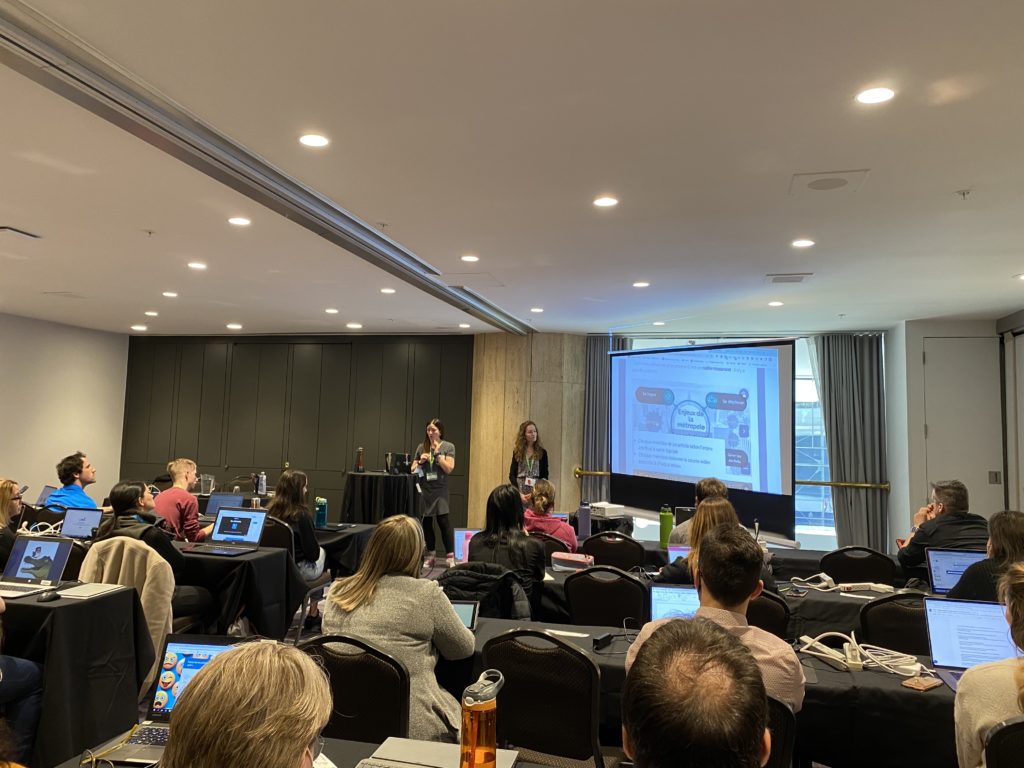Dominique Bernier et Marie-Andrée Arsenault sont toutes deux enseignantes en première secondaire au Collège Saint-Hilaire. Elles ont adopté le plan de travail comme stratégie pédagogique avec leurs élèves. Elles ont partagé leur expérience (et quelques astuces!) lors d’un atelier présenté au colloque de l’AQUOPS.
« Le plan de travail permet de rapidement faire des ponts entre ce qui est expliqué et la façon dont l’élève peut l’appliquer concrètement. Il permet de faire des liens entre les différents éléments enseignés, tout en cumulant une multitude de traces de la progression des élèves », ont expliqué les deux enseignantes en début d’atelier.

Afin de préparer leurs plans de travail, elles effectuent une planification à rebours des objectifs à atteindre. Elles segmentent ensuite les tâches par séquence afin de préparer les plans.
Parmi les conseils qu’elles donnent aux enseignants qui désirent adopter cette façon de faire, en voici trois :
- Ne réinventez pas la roue
- Acceptez que ce soit imparfait
- Repensez votre rapport à l’évaluation
Avec des élèves du secondaire
Bien que le plan de travail soit souvent associé au primaire, elles ont confirmé que cette stratégie fonctionne très bien avec les élèves du secondaire. « Ils ont hâte de travailler en plan de travail! »
Selon elles, grâce à son utilisation, les élèves développent leur autonomie et s’engagent rapidement dans leurs apprentissages. Ils apprécient particulièrement avoir le choix de l’ordre des tâches à réaliser et même des tâches elles-mêmes dans certains cas, le fait d’avancer à leur rythme, d’avoir des activités bonus à compléter. Finalement, ce type de stratégie facilite grandement les suivis avec les élèves qui doivent s’absenter.
Afin de préparer leurs plans de travail, elles utilisent différents outils technologiques tels que Padlet, Canva, Genially, PowerPoint, Google Slides. Elles ont présenté différents exemples que les enseignants peuvent réutiliser et personnaliser.
Les différentes façons d’utiliser le plan de travail
Le plan de travail peut être utilisé dans différents contextes qu’elles ont présenté au cours de leur atelier.
Pour un cours
- Aide à implanter une routine, peu importe le niveau;
- Permet à la majorité de la classe de travailler individuellement pendant que l’enseignant se consacre aux apprenants éprouvant des difficultés;
- Donne du sens à une leçon en l’associant à une thématique ou à une intention;
- Un petit questionnaire peut être utilisé en fin de période, comme un billet de sortie, pour témoigner des apprentissages faits.
Pour un cycle ou pour un mois
- Donne aux élèves une vision d’ensemble du chemin à parcourir et des étapes à suivre en rassemblant tout au même endroit;
- Offre à l’enseignant la possibilité d’y intégrer différentes séquences pour travailler diverses compétences en parallèle (plusieurs plans de travail peuvent alors s’entrecroiser);
- Il peut être judicieux de fournir des corrigés en cours de séquence pour que les élèves aient de la rétroaction.
Pour un projet
- Permet de présenter facilement les tâches à réaliser en équipe;
- Aide les élèves à se partager les tâches;
- Offre un cadre rassurant pour les élèves qui sont plus anxieux lors des travaux d’équipe;
- Facilite le suivi des parents voulant s’impliquer à la maison pour encadrer leur enfant.
Pour une suppléance
- Facilite la transmission des consignes aux suppléants et aux élèves;
- Engage les élèves pendant les périodes de suppléance en leur donnant des choix et options de tâches;
- Simplifie la gestion de classe des suppléants car les élèves sont engagés.
Pour une révision
- Donne des pistes et des ressources variées aux élèves et à leur parents souhaitant s’impliquer (repérage rapide de la matière importante à réviser);
- Peut être utilisé en classe, comme à la maison. Les tâches de révision peuvent être reprises plusieurs fois;
- Amène certains jeunes à transférer leurs apprentissages en créant à leur tour des jeux pour réviser.
Lors de leur atelier présenté au colloque de l’AQUOPS, Dominique et Marie-Andrée avaient même fait un plan de travail pour les participants qui devaient à leur tour en créer un pour leurs élèves. Comme quoi cette stratégie peut être utilisée de multiples façons!
La présentation, faite avec Genially, est disponible pour tous.
Pour aller plus loin :
- À lire : 5 éléments à considérer pour dynamiser votre plan de travail
- Le plan de travail numérique pour apprendre à son rythme (formation présentée par Laurie Couture, de l’École branchée, lors de la Journée du numérique en éducation 2021)




 Recevez l'Info #DevProf et l'Hebdo pour ne rien manquer des nouveautés de l'École branchée!
Recevez l'Info #DevProf et l'Hebdo pour ne rien manquer des nouveautés de l'École branchée!




